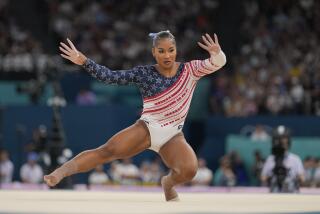World Gymnastics Officials Say Score Fixing Is Hard to Control
- Share via
A spokesman for the International Federation of Gymnastics (FIG) said Thursday that the sport’s governing body is aware that countries make deals to fix scoring in competitions, but said the collaboration is difficult to police.
“Everybody is aware of this thing, but no one can prove it,” said Frank Edmond, vice president of FIG.
Edmond, reached in Bristol, England, was responding to a claim by Greg Marsden, former U.S. women’s gymnastics coach, who said that officials from the United States and Romania conspired to fix scores at the 1987 World Championships in Rotterdam, the Netherlands.
“No one will admit it, and that makes it difficult to prove,” Edmond said. “If it existed in this incident and what this chap (Marsden) said is true, the other chap (Romanian Coach Adrian Goreac) has to agree, or we have no case.”
Repeated attempts by The Times to reach the Romanian coach have failed.
Marsden said that he and Goreac exchanged scores that were to be delivered to the countries’ respective judges. The scores were what each country wanted its athletes to receive.
The deal fell through when the Romanians performed well enough to receive the marks they requested. The U.S. gymnasts, however, performed too poorly for the Romanian judge to comply without bringing undo attention to the score.
Marsden said the deal to collaborate was agreed to by himself, the coaching staff and the U.S. judges. Both judges, Audrey Schweyer and Joanne Pasqualle, denied knowing about an agreement with Romania. Mike Jacki, executive director of the U.S. Gymnastics Federation, also denied the charge, but said that collusion is an issue in international competition.
Edmond said the FIG sponsored a symposium last year in Rome that dealt with scoring in gymnastics. Among the issues discussed was corruption among officials.
Since then, FIG has made plans to implement a new computerized scoring system, which will allow scoring by judges to be examined instantaneously by the technical committee, which presides over the judging during competition.
“With this new system, we hope to control this type of horse trading,” Edmond said. “A computerized graph will keep track of a judge’s recurring bias, whether the bias is for or against.”
With the graph, the technical committee will be able to spot any unusual scoring. If that’s the case, the judge will first be warned, and if there is a second occurrence, suspended.
Edmond says the FIG has already increased the number of judges from four to six, with the high and low score thrown out and the middle four averaged. This was done to diminish the value of scores that seem overly high or low.
“This scoring system makes it difficult for a judge to show undo bias, unless the whole darn lot are crooked,” Edmond said.
Yuri Titov, president of the FIG, declined to comment on the U.S.-Romanian incident or score fixing in gymnastics. He would only say there are problems in all sports, not just gymnastics.
Hardy Fink, coach of Canada’s national men’s gymnastics team and a longtime international gymnastics judge, points to 1975 as the time that score fixing became an issue. It was then that FIG instituted a new procedure for countries to qualify for the Montreal Olympics in 1976. Until then, there were few countries competing in gymnastics, and qualifying was not necessary.
“Each country had to compete in two meets with the scores added together, but the problem was that you could choose any country you wanted to compete against,” Hardy said. “So countries would watch the scores from other meets, and figure out what they needed to qualify for the Olympics.
“That’s when I believe gymnastics lost its innocence, and everyone learned how to cheat. It got so bad that myself and a delegation from Canada went to FIG and argued until it was forced to have a qualifying meet, which they did in 1976.”
Fink says he believes collusion between countries has bottomed out since 1976, that his team was a victim of deal-making at the 1987 World Championships.
“We suffered from collusion on the last couple of events, but then, our gymnasts also didn’t do so well,” Fink said, declining to elaborate.
Fink says he is no longer approached by other countries because he never cooperated in the past. He did, however, give an example of how a judge can help throw a meet.
“In men’s gymnastics, there are still only four judges, with the high and low score tossed and the middle two averaged,” Fink said.
“If I am judging and a Soviet athlete competes and the performance is a solid 9.8 (out of 10.0), I know the Soviet judge on our panel is going to to give the athlete a 9.9, the Japanese judge will score a 9.7 and the British judge will be neutral and score it a 9.8.
“So, if I want to side with Japan, I make my score a 9.7, and the athlete will end up with a 9.75. If I want to side with the Soviets, I score a 9.9, and it will average to a 9.85.
“If I want to play the game, after judging 12 teams, I can make a difference in one point of a country’s total score. I don’t do it, but the potential is certainly there.”
More to Read
Go beyond the scoreboard
Get the latest on L.A.'s teams in the daily Sports Report newsletter.
You may occasionally receive promotional content from the Los Angeles Times.






